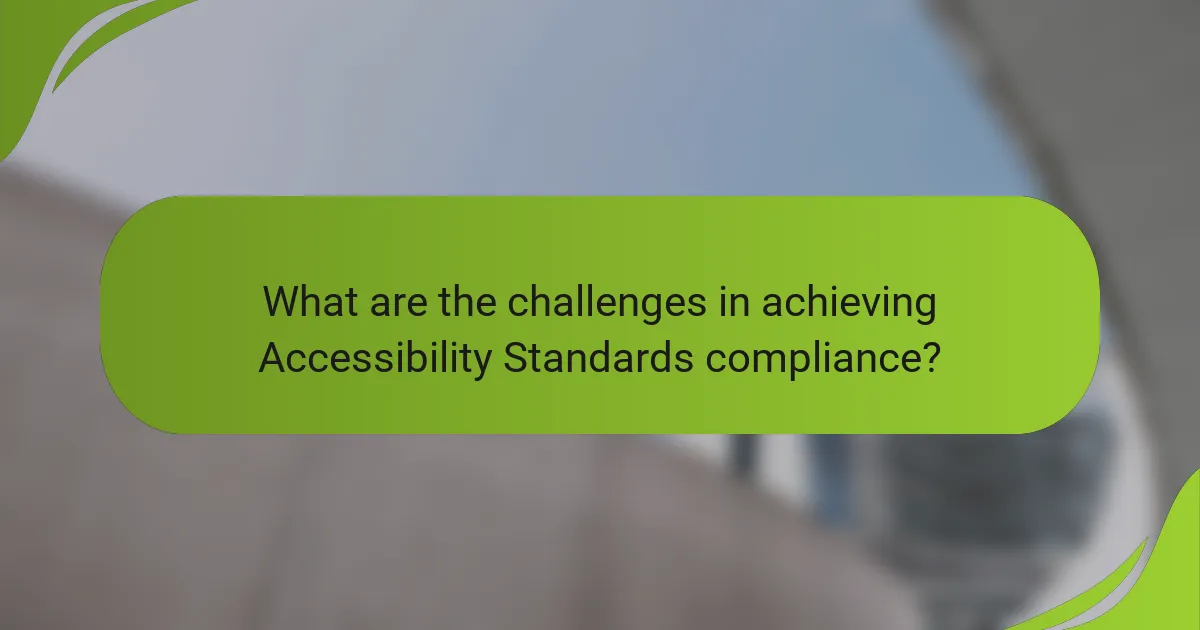Accessibility standards are essential guidelines that ensure environments are usable by individuals with disabilities, promoting inclusivity and equal access. Approximately 15% of the global population lives with some form of disability, highlighting the importance of compliance with these standards for architects and designers. The article addresses the challenges of achieving compliance, including a lack of awareness, complexity of existing infrastructure, budget constraints, varying interpretations of standards, and insufficient training for professionals. Best practices for maintaining compliance are also discussed, such as conducting regular audits, training staff, implementing feedback mechanisms, and involving users with disabilities in the design process. This comprehensive analysis emphasizes the critical role accessibility standards play in fostering an equitable society.

What are Accessibility Standards and Why are They Important?
Accessibility standards are guidelines that ensure environments are usable by people with disabilities. They provide a framework for designing buildings, products, and services that accommodate various needs. These standards are important because they promote inclusivity and equal access for all individuals. Research indicates that approximately 15% of the global population lives with some form of disability. By adhering to accessibility standards, architects and designers can create spaces that foster independence and dignity for everyone. Compliance with these standards is often legally required, ensuring protection against discrimination. Therefore, accessibility standards play a crucial role in shaping a more equitable society.
How do Accessibility Standards impact architectural design?
Accessibility standards significantly impact architectural design by mandating specific features to ensure inclusivity. These standards require the incorporation of ramps, wide doorways, and accessible restrooms. They also dictate the placement of signage and the design of pathways. Compliance with these standards enhances usability for individuals with disabilities. The Americans with Disabilities Act (ADA) sets forth these requirements in the United States. Architectural firms must integrate these guidelines during the design phase. Failure to comply can result in legal repercussions and loss of business. Overall, accessibility standards shape the functionality and safety of built environments.
What are the key components of Accessibility Standards?
The key components of Accessibility Standards include guidelines for design, usability, and technology. These components ensure that environments are navigable for all individuals, including those with disabilities. Design guidelines focus on physical accessibility, such as ramps and door widths. Usability components address the ease of use for various devices and interfaces. Technology standards ensure that digital content is accessible, including websites and applications. Compliance with these standards is often mandated by law, such as the Americans with Disabilities Act (ADA) in the United States. These standards are regularly updated to reflect current best practices and technological advancements.
How do Accessibility Standards promote inclusivity in architecture?
Accessibility standards promote inclusivity in architecture by establishing guidelines that ensure built environments are usable by all individuals. These standards address various needs, including those of people with disabilities, the elderly, and families with young children. They mandate features such as ramps, wider doorways, and accessible restrooms. Compliance with these standards helps eliminate barriers that restrict access. For instance, the Americans with Disabilities Act (ADA) outlines specific requirements for accessible design. Research shows that inclusive architecture enhances usability for everyone, not just individuals with disabilities. This universal design approach fosters a sense of belonging and community.
What are the main types of Accessibility Standards?
The main types of Accessibility Standards include the Americans with Disabilities Act (ADA), Web Content Accessibility Guidelines (WCAG), and Section 508 of the Rehabilitation Act. The ADA establishes requirements for accessible design in buildings and facilities. WCAG focuses on making web content more accessible to individuals with disabilities. Section 508 mandates that federal agencies ensure their electronic and information technology is accessible to people with disabilities. These standards aim to create an inclusive environment across various platforms and physical spaces.
What is the difference between national and international Accessibility Standards?
National accessibility standards are regulations established within a specific country, focusing on local needs and legal requirements. These standards address the unique cultural, social, and economic contexts of that nation. In contrast, international accessibility standards are guidelines developed to be applicable across multiple countries, promoting a universal approach to accessibility. They aim to create consistency in accessibility practices globally.
National standards may vary significantly from one country to another. For example, the Americans with Disabilities Act (ADA) sets specific requirements in the United States. Conversely, international standards, such as the ISO 21542, provide a framework that can be adapted by various nations. The implementation of international standards can enhance global cooperation and understanding in accessibility efforts.
How do local regulations influence Accessibility Standards?
Local regulations significantly shape Accessibility Standards. They establish mandatory guidelines for public spaces and buildings. Compliance with these regulations ensures that facilities accommodate individuals with disabilities. Local governments often adapt national standards to fit community needs. Variations may arise based on regional demographics and specific accessibility challenges. For instance, urban areas may face different issues compared to rural settings. Local regulations can also dictate enforcement mechanisms and penalties for non-compliance. This localized approach promotes inclusivity tailored to specific populations.
How can organizations ensure compliance with Accessibility Standards?
Organizations can ensure compliance with Accessibility Standards by implementing comprehensive training programs. These programs should educate staff about the specific standards and guidelines, such as the Americans with Disabilities Act (ADA) and Web Content Accessibility Guidelines (WCAG). Regular audits of facilities and digital content are essential to identify accessibility issues. Organizations should also involve individuals with disabilities in the evaluation process to gather firsthand insights. Establishing clear policies and assigning responsibility for accessibility compliance can enhance accountability. Furthermore, keeping up with updates to accessibility laws and standards is crucial for ongoing compliance. Research shows that organizations that prioritize accessibility benefit from improved user experience and broader audience reach.
What are the steps to conduct an Accessibility Standards analysis?
Identify the relevant accessibility standards applicable to the project. Review documents such as the ADA, Section 508, or WCAG. Conduct a site assessment to evaluate current compliance levels. Analyze architectural plans and existing structures against the identified standards. Engage stakeholders, including individuals with disabilities, for their insights. Document findings in a detailed report outlining compliance gaps. Recommend corrective actions to address identified issues. Prioritize recommendations based on impact and feasibility.
How can technology assist in ensuring compliance?
Technology assists in ensuring compliance by automating monitoring and reporting processes. Automated tools can track adherence to accessibility standards in real-time. These tools analyze architectural designs against established guidelines. They provide alerts for non-compliance issues as they arise. Data analytics can identify patterns in compliance failures. This allows for proactive adjustments before final inspections. Additionally, technology offers training modules for stakeholders on compliance requirements. Real-time feedback mechanisms enhance understanding and implementation of standards. Studies show that organizations using technology for compliance see improved adherence rates.

What are the challenges in achieving Accessibility Standards compliance?
Achieving Accessibility Standards compliance presents several challenges. One major challenge is the lack of awareness among stakeholders about specific standards. Many architects and builders may not fully understand the requirements outlined in regulations like the ADA or WCAG. Another challenge is the complexity of existing infrastructure. Retrofitting older buildings to meet modern accessibility standards can be costly and technically difficult.
Additionally, budget constraints often limit the ability to implement necessary changes. Organizations may prioritize other projects over accessibility improvements. The varying interpretations of standards can also create confusion. Different jurisdictions may enforce accessibility regulations differently, leading to inconsistencies.
Lastly, there is often insufficient training for professionals in the field. Without proper education on accessibility standards, compliance becomes more difficult. These factors collectively hinder the achievement of Accessibility Standards compliance.
What common barriers do architects face in implementing Accessibility Standards?
Architects face several common barriers in implementing Accessibility Standards. These barriers include limited knowledge of regulations and guidelines. Many architects lack training in accessibility design. This can lead to unintentional non-compliance. Financial constraints also pose significant challenges. Budget limitations can restrict the implementation of necessary modifications. Additionally, resistance to change is a frequent issue. Stakeholders may prioritize aesthetics over accessibility. Lastly, insufficient collaboration with accessibility experts often occurs. This can result in overlooking critical design elements. These barriers collectively hinder the effective implementation of Accessibility Standards in architecture.
How can budget constraints affect compliance efforts?
Budget constraints can significantly hinder compliance efforts in accessibility standards. Limited financial resources restrict the ability to implement necessary modifications. Organizations may prioritize essential operations over compliance investments. This can lead to inadequate facilities that do not meet legal requirements. For instance, a study by the National Council on Disability found that budget limitations often result in deferred maintenance and upgrades. Consequently, this can increase the risk of non-compliance penalties. Additionally, insufficient funds may limit training for staff on accessibility standards. Overall, budget constraints directly impact the ability to achieve and maintain compliance in inclusive architecture.
What role does stakeholder engagement play in overcoming challenges?
Stakeholder engagement plays a crucial role in overcoming challenges in accessibility standards compliance. Engaging stakeholders fosters collaboration among architects, builders, and community members. This collaboration helps identify specific needs and barriers related to accessibility. It also ensures that diverse perspectives are considered in the design process. Research indicates that projects with active stakeholder involvement are more likely to meet compliance standards. For instance, a study by the National Institute of Building Sciences found that inclusive design processes reduce costly rework and enhance user satisfaction. Engaging stakeholders ultimately leads to more effective and sustainable solutions in architecture.
How can organizations measure the effectiveness of their compliance efforts?
Organizations can measure the effectiveness of their compliance efforts through various metrics and assessments. They can conduct regular audits to evaluate adherence to accessibility standards. Surveys and feedback from users can provide insights into the real-world impact of compliance. Training effectiveness can be assessed through knowledge tests for employees. Tracking incident reports related to accessibility can highlight areas needing improvement. Compliance certifications from recognized bodies serve as external validation of efforts. Data analytics can reveal trends in accessibility-related issues over time. These methods collectively provide a comprehensive view of compliance effectiveness.
What metrics can be used to evaluate Accessibility compliance?
Metrics used to evaluate Accessibility compliance include WCAG success criteria, user testing results, and automated accessibility testing scores. WCAG success criteria provide a framework for measuring compliance with web accessibility standards. User testing results reflect real-world experiences of individuals with disabilities. Automated accessibility testing tools, such as Axe or WAVE, generate scores based on predefined accessibility checks. Together, these metrics offer a comprehensive assessment of Accessibility compliance.
How can feedback from users improve compliance strategies?
User feedback can significantly enhance compliance strategies by providing insights into real-world experiences. This feedback highlights specific areas where compliance measures may fall short. For instance, users can identify barriers that regulations may not address. Their input can guide adjustments to existing compliance protocols. Additionally, feedback can reveal the effectiveness of current strategies in practice. By analyzing this information, organizations can refine their approaches to better meet accessibility standards. Studies have shown that organizations implementing user feedback see improved compliance outcomes. This iterative process fosters a more inclusive environment for all users.

What are best practices for ensuring ongoing compliance with Accessibility Standards?
Best practices for ensuring ongoing compliance with Accessibility Standards include regular audits and updates. Conducting accessibility audits identifies areas needing improvement. These audits should be performed at least annually. Training staff on accessibility guidelines is crucial. Employees must understand the importance of compliance. Implementing a feedback mechanism allows users to report accessibility issues. This feedback can guide necessary changes. Staying informed about updates to accessibility laws is essential. Organizations should review relevant legislation regularly. Finally, involving users with disabilities in the design process enhances compliance. Engaging these users provides valuable insights into their needs.
What strategies can organizations adopt for continuous improvement?
Organizations can adopt several strategies for continuous improvement. Implementing regular training programs enhances employee skills and knowledge. Utilizing feedback mechanisms allows organizations to gather insights from stakeholders. Conducting performance assessments identifies areas for growth. Establishing a culture of innovation encourages creative solutions. Utilizing data analytics helps in making informed decisions. Benchmarking against industry standards provides a framework for comparison. These strategies collectively foster an environment of ongoing enhancement and adaptation.
How can training and education enhance compliance efforts?
Training and education enhance compliance efforts by equipping individuals with the necessary knowledge and skills. This understanding of regulations helps ensure adherence to accessibility standards. Employees trained in compliance are more likely to recognize potential issues. They can identify areas where accessibility may be lacking. Effective training programs can lead to increased awareness of legal obligations. Education fosters a culture of accountability within organizations. Research shows that organizations with ongoing training see lower rates of non-compliance. A study by the National Center on Accessibility indicates that informed staff can significantly improve compliance outcomes.
What role do audits and assessments play in maintaining standards?
Audits and assessments are critical in maintaining standards for accessibility. They systematically evaluate compliance with established guidelines. Regular audits identify gaps in adherence to accessibility standards. Assessments provide a framework for measuring effectiveness in implementation. These processes ensure that facilities meet legal and ethical obligations. They also promote continuous improvement in accessibility practices. Research indicates that organizations performing regular audits report higher compliance rates. This leads to better outcomes for users with disabilities.
What resources are available for organizations seeking to improve Accessibility compliance?
Organizations seeking to improve accessibility compliance can utilize various resources. The Web Content Accessibility Guidelines (WCAG) provide a comprehensive framework for digital accessibility. The Americans with Disabilities Act (ADA) outlines legal requirements for physical spaces. Accessibility audits conducted by certified professionals can identify compliance gaps. Training programs for staff on accessibility best practices enhance organizational knowledge. Online courses and webinars offer flexible learning opportunities. Government resources, such as the U.S. Access Board, provide guidelines and technical assistance. Nonprofit organizations also offer tools and resources tailored for specific sectors. These resources collectively support organizations in achieving and maintaining accessibility compliance.
How can professional organizations support compliance efforts?
Professional organizations can support compliance efforts by providing resources, training, and advocacy. They offer guidelines on accessibility standards relevant to inclusive architecture. These organizations often host workshops and seminars to educate members on compliance practices. They also create toolkits that outline best practices for meeting regulatory requirements. Additionally, professional organizations advocate for policy changes that enhance compliance frameworks. They may collaborate with governmental bodies to influence legislation. Such initiatives help ensure that members stay informed about evolving standards. By fostering a culture of compliance, these organizations contribute to the overall improvement of accessibility in architecture.
What online tools and resources can aid in understanding Accessibility Standards?
Online tools and resources that aid in understanding Accessibility Standards include the Web Content Accessibility Guidelines (WCAG) website, which provides comprehensive guidelines. The Accessibility Checker by WAVE offers a free online evaluation of web content for accessibility issues. The Accessibility Insights tool helps developers find and fix accessibility issues in their applications. The ADA National Network provides resources and information on the Americans with Disabilities Act. The Inclusive Design Toolkit offers strategies for designing accessible products and services. The Center for Inclusive Design and Environmental Access (IDeA) provides research and resources on inclusive design practices. These resources collectively enhance understanding of accessibility standards and promote compliance in architecture and design.
What are practical tips for architects to ensure inclusive design?
Architects can ensure inclusive design by prioritizing accessibility for all users. They should incorporate universal design principles that accommodate diverse needs. Engaging with community stakeholders during the design process is crucial. This helps identify specific accessibility requirements. Conducting thorough site analyses can reveal potential barriers. Architects should also stay updated on accessibility standards and regulations. Utilizing adaptive technologies can enhance usability for individuals with disabilities. Regularly reviewing and testing designs with actual users can provide valuable feedback.
Accessibility standards are guidelines that ensure environments are usable by individuals with disabilities, promoting inclusivity and equal access. This article analyzes the impact of these standards on architectural design, including key components, types, and the influence of local regulations. It highlights the challenges architects face in compliance, the importance of stakeholder engagement, and best practices for ongoing adherence to accessibility standards. Additionally, it addresses how technology can assist in compliance efforts and provides resources for organizations seeking to improve their accessibility practices.